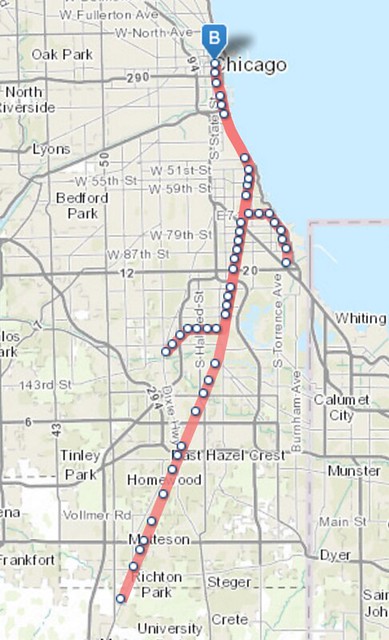
A dozen neighborhood organizations, along with the Active Transportation Alliance and the Center for Neighborhood Technology, are calling for the Metra Electric line, with its three branches that run through several South Side communities, to operate like a CTA 'L' line.
The fourteen organizations signed a letter to the editor of the Chicago Maroon, the independent student newspaper of the University of Chicago, stating that if Metra Electric trains were operated more like the Blue and Red Lines, "[it] could unlock the enormous development potential of the South Side and South Suburbs." They described the neighborhoods and places the trains already reach:
The Metra Electric serves many key destinations on the South Side, such as the University of Chicago, the Pullman district, Chicago State University, the Museum of Science and Industry, Governor’s State University, McCormick Place, the South Shore Cultural Center, and the proposed Lakeside Development. The communities surrounding its stations are densely populated and walkable, ideal areas for rapid transit development.
The groups are absolutely right that the areas around the stations would be ideal for rapid transit service. They specifically ask transit agency heads and elected officials to make the following happen:
- integrate fares and schedules with CTA and Pace operations, because the Metra Electric "is hampered by a fare structure more appropriate for suburban lines"
- allow for discounted transfers among Metra and CTA and Pace
- increase frequencies to 10-15 minutes
Many Chicagoans may be unaware that the Electric Line used to run at that frequency. Trains ran from Randolph Street Station (now Millennium Station) to the 93rd Street station in South Chicago every 10 minutes for nearly 15 years, until April 1949, according to a 2006 issue of First & Fastest, a quarterly transit magazine. They ran every 20 or 30 minutes up until September 1981, when service was reduced to hourly.
The letter asks for a study to determine how much funding would be needed to extend the Metra Electric to O'Hare Airport. The Midwest High Speed Rail Association, a signatory, calls this project "CrossRail." It would involve building a couple of connections for Electric Line trains to switch over to other Metra lines and electrifying existing track to create a continuous route to the airport.
The groups also ask for more federal, state, and local funding in order to make their vision a reality. Right now, Metra doesn't appear to have funding to run more trains. In recent years, they've raised fares without increasing service. And two stations they've been planning to build in Edgewater and Auburn Gresham are currently on hold due to the budget stalemate in Springield.
The idea of turning the Electric Line into a rapid transit route isn't a new one. For years, local advocate Mike Payne has been pushing a similar proposal called the "Gray Line."
And Active Trans and CNT's Transit Future campaign for increased funding for public transportation at the county level, calls for the creation of several new rapid transit line. They refer to rapid transit service on the Electric Line as the "Gold Line."
The 14 organizations that signed the letter to the Maroom are essentially asking for a return to historic service levels. Their movement is supported by the fact that the Electric Line has good infrastructure, including new train cars, and Metra has new leadership. The next step is to win support for the idea from local, state, and federal leaders.
![]()
Did you appreciate this post? Streetsblog Chicago is currently funded until April 2016. Consider making a donation through our PublicGood site to help ensure we can continue to publish next year.




